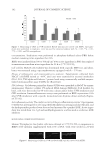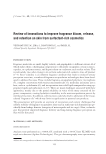J. Cosmet. Sci., 68, 48–54 (January/February 2017) 48 Addressing epidemic of para-phenylenediamine sensitization by going forward into the past CATHERINE CARTWRIGHT-JONES, TapDancing Lizard LLC. The epidemic of sensitization to para-phenylenediamine (PPD) will cause loss of client base for oxidative hair dye. Generalizing from the results of a broad UK sensitization as- say of adolescents in 2014, 16% of adults in western industrialized nations are now sen- sitized to PPD by the time they begin to gray in 2030, all of these people will be unable to use oxidative hair dye and other products containing coal tar derivatives and 7% may have reactions severe enough to require hospitalization (1). Many with extreme PPD reac- tions were sensitized by “black henna” temporary tattoos (2). In East Africa, the practice of decorating skin with PPD to create “black henna” temporary tattoos has been popular since the 1970s (3) levels of sensitization are very high Khartoum, Sudan, now has over 300 hospital admissions each year from high systemic exposure to PPD (4). North Africa, the Arabian Peninsula, and South Asia, where people have used “black henna” since the 1980s also have a high rate of hospital admissions related to the health consequences of PPD exposure. The popularity of “black henna” temporary tattooing is not the sole driver of this epi- demic. Childhood use of hair dye, particularly inept applications of home hair dye kits by teenagers during the Punk, Emo, and Goth eras, has elevated the number of sensitiza- tions. The black henna temporary tattoos appear to be responsible for the severe reactions and cross-sensitization to related chemicals (5). Black hair dye products imported from India, Pakistan, Japan, and China containing 20–40% PPD have contributed to the se- verity of sensitizations (6). The current severe (+++) sensitization reactions and deaths being reported now have not been seen since the early 1900s when PPD dyes for hair were not regulated at 6% PPD or lower (7). Because of the high dye percentage and large body area applications of PPD in “black henna,” many people are sensitized to other diamine-related chemicals and must avoid the entire portfolio of cosmetic chemicals, which have proceeded from the initial synthesis of aniline dyes in the mid-1800s. Development and promotion of “safer oxida- tive” hair formulas may result in more injuries as many people sensitized through “black henna” temporary tattoos are cross-sensitized to chemically similar compounds (8). According to a 2016 survey by the British Skin Foundation, two-thirds of British derma- tologists have seen an increase in patients with reactions to hair dyes, many of whom have Address all correspondence to Catherine Cartwright-Jones at reverndbunny@earthlink.net.
EPIDEMIC OF PARA-PHENYLENEDIAMINE SENSITIZATION 49 previously had a “black henna” temporary tattoo (9). If a signifi cant number of the client base becomes unable to use chemical hair dye, and the chemical cosmetic industry does not want to lose that revenue, an alternative to coal tar–derivative dyes must be developed. WHY HENNA DISAPPEARED FROM COSMETOLOGY PRACTICE Before the invention of oxidative dyes, there was a permanent, gray-covering, nonfading hair dye technology based on henna, partially fermented indigo, cassia, and fruit acids. The older plant-based hair dye techniques were learned and shared in the village baths of North Africa, the Levant, Arabia, India, and the Middle East these hair dye practices were refi ned generation after generation and regarded as the safest, most reliable, most attractive thing a person could use on hair. Colonial expansion into these countries brought these dyes to Europe, where they became the height of fashion in the late 1800s and into the early 1900s. Women’s long, fl owing red hair celebrated in Art Nouveau and the brilliant red hair shown in Toulouse-Lautrec’s paintings of women show European women’s delight in henna, the newly available exotic wonder. Sarah Bernhardt hennaed her graying hair, as did many other divas, and their admirers followed suit. The popularity and reliability of henna were disrupted when World Wars I and II inter- rupted the henna supply chain from the Ottoman Empire, Egypt, and North Africa. B. Paul and other American hair dye companies added mineral salts to inferior low-grade henna base to stretch a scant and inferior supply when henna became diffi cult to import. These additives also were meant to compensate for the lack of traditional knowledge when henna products were sold outside of the native region. These products were mar- keted as “henna compounds.” Compound henna hair dye products currently in the mar- ketplace have a justifi ably terrible reputation in the cosmetic industry based on the destructive cross reactions between mineral salts and the activators for oxidative hair dye. These are, most notoriously, sodium picramate, lead acetate, silver nitrate, copper, nickel, cobalt, bismuth, and iron (10). If these additives are undeclared, or the declaration is obscured, hairdressers conclude that henna itself is to blame. Most compound henna products contain low-dye-content plant materials, misunderstood chemistry, and additives masking the poor botanical quality. These compromise the color outcome while pushing profi ts higher and undermine what once was, and what should be, a very benefi cial product. The compound henna hair dye products presently in the marketplace are a case study in what can go wrong when market forces tinker with a reli- able and serviceable product with the intent of improving convenience, uniformity, pre- dictability, and profi tability until the original good of the product is compromised to the point of near uselessness. Pure henna, indigo, and cassia in varying proportions can dye hair in the full range of human hair color and allow people who have been sensitized to PPD to transition away from oxidative hair dye without having to grow out their hair. If 16% of hair-dying population will need to switch to henna because of sensitization, how much supply must be obtained, and how will it be possible to re-educate the consumer and cosmetologists to transit these people to henna? One kilogram of plant powder per year is suffi cient for one person to permanently color hair, doing monthly root growth. Suffi cient supplies will have to be planned for, grown, milled, and harvested to the standards western consumers expect. The coarsely sifted henna presently in the marketplace will not be acceptable to
Purchased for the exclusive use of nofirst nolast (unknown) From: SCC Media Library & Resource Center (library.scconline.org)












































































































































